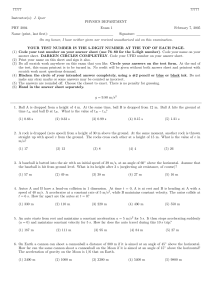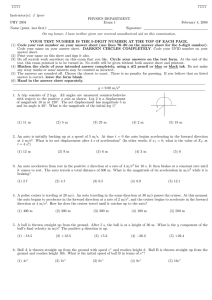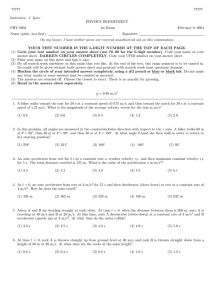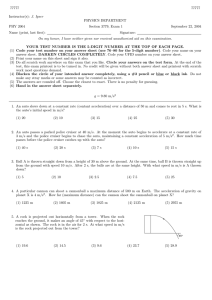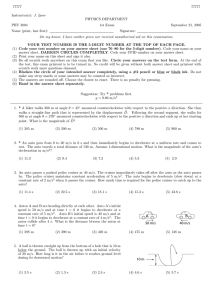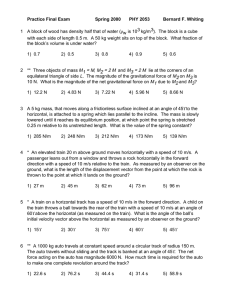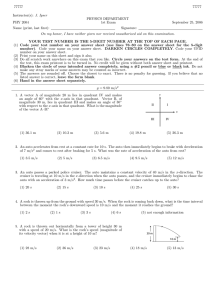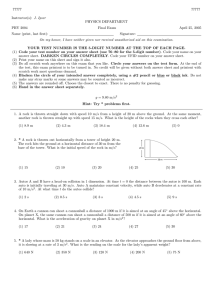77777 J. Ipser PHYSICS DEPARTMENT PHY 2004
advertisement
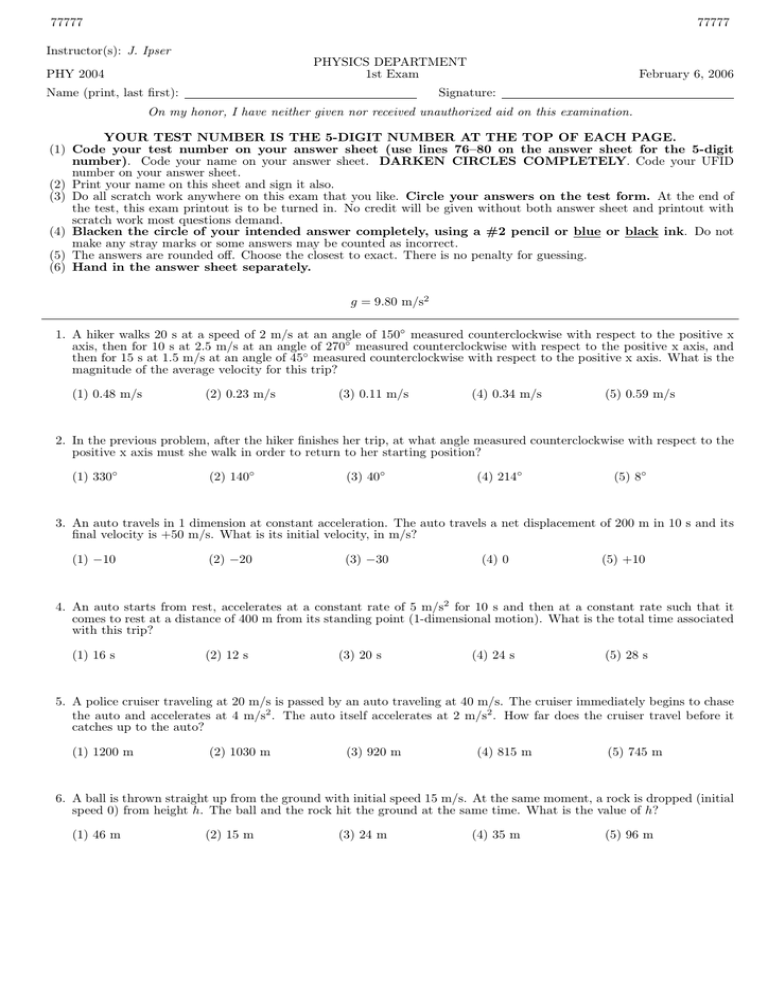
77777 77777 Instructor(s): J. Ipser PHYSICS DEPARTMENT 1st Exam PHY 2004 Name (print, last first): February 6, 2006 Signature: On my honor, I have neither given nor received unauthorized aid on this examination. YOUR TEST NUMBER IS THE 5-DIGIT NUMBER AT THE TOP OF EACH PAGE. (1) Code your test number on your answer sheet (use lines 76–80 on the answer sheet for the 5-digit number). Code your name on your answer sheet. DARKEN CIRCLES COMPLETELY. Code your UFID number on your answer sheet. (2) Print your name on this sheet and sign it also. (3) Do all scratch work anywhere on this exam that you like. Circle your answers on the test form. At the end of the test, this exam printout is to be turned in. No credit will be given without both answer sheet and printout with scratch work most questions demand. (4) Blacken the circle of your intended answer completely, using a #2 pencil or blue or black ink. Do not make any stray marks or some answers may be counted as incorrect. (5) The answers are rounded off. Choose the closest to exact. There is no penalty for guessing. (6) Hand in the answer sheet separately. g = 9.80 m/s2 1. A hiker walks 20 s at a speed of 2 m/s at an angle of 150◦ measured counterclockwise with respect to the positive x axis, then for 10 s at 2.5 m/s at an angle of 270◦ measured counterclockwise with respect to the positive x axis, and then for 15 s at 1.5 m/s at an angle of 45◦ measured counterclockwise with respect to the positive x axis. What is the magnitude of the average velocity for this trip? (1) 0.48 m/s (2) 0.23 m/s (3) 0.11 m/s (4) 0.34 m/s (5) 0.59 m/s 2. In the previous problem, after the hiker finishes her trip, at what angle measured counterclockwise with respect to the positive x axis must she walk in order to return to her starting position? (1) 330◦ (2) 140◦ (3) 40◦ (4) 214◦ (5) 8◦ 3. An auto travels in 1 dimension at constant acceleration. The auto travels a net displacement of 200 m in 10 s and its final velocity is +50 m/s. What is its initial velocity, in m/s? (1) −10 (2) −20 (3) −30 (4) 0 (5) +10 4. An auto starts from rest, accelerates at a constant rate of 5 m/s2 for 10 s and then at a constant rate such that it comes to rest at a distance of 400 m from its standing point (1-dimensional motion). What is the total time associated with this trip? (1) 16 s (2) 12 s (3) 20 s (4) 24 s (5) 28 s 5. A police cruiser traveling at 20 m/s is passed by an auto traveling at 40 m/s. The cruiser immediately begins to chase the auto and accelerates at 4 m/s2 . The auto itself accelerates at 2 m/s2 . How far does the cruiser travel before it catches up to the auto? (1) 1200 m (2) 1030 m (3) 920 m (4) 815 m (5) 745 m 6. A ball is thrown straight up from the ground with initial speed 15 m/s. At the same moment, a rock is dropped (initial speed 0) from height h. The ball and the rock hit the ground at the same time. What is the value of h? (1) 46 m (2) 15 m (3) 24 m (4) 35 m (5) 96 m 77777 77777 7. A rock is thrown out from a tower of height 20 m at an angle of 30◦ above the horizontal. The initial speed of the rock is 20 m/s. What is the angle that the rock’s velocity makes with respect to the ground just before it hits the ground? 30o 20 m α (1) 52◦ (2) 89◦ (3) 64◦ (4) 32◦ (5) 43◦ 8. Golfer A hits golf ball A at an angle of 60◦ above the horizontal on the Moon, and the golf ball travels 500 m before it hits the Moon’s surface. Just before hitting the surface, its speed is vA . Golfer B hits golf ball B at an angle of 15◦ above the horizontal on Earth, and the gold ball travels 100 m before it hits the Earth’s surface. Just before hitting the surface, its speed is vB . What is the value of vvB . The acceleration of gravity on the Moon is 1/6 that on Earth. A (1) 1.44 (2) 1.65 (3) 0.96 (4) 0.73 (5) 0.21 THE FOLLOWING QUESTIONS, NUMBERED IN THE ORDER OF THEIR APPEARANCE ON THE ABOVE LIST, HAVE BEEN FLAGGED AS CONTINUATION QUESTIONS: 2
